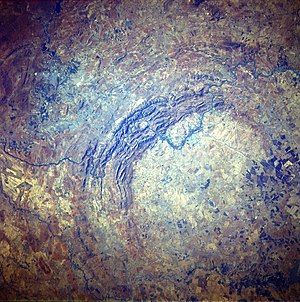| Vredefort Dome* | |
|---|---|
| UNESCO World Heritage Site | |
 | |
| State Party | |
| Type | Natural |
| Criteria | viii |
| Reference | 1162 |
| Region** | Africa |
| Inscription history | |
| Inscription | 2005 (29th Session) |
| * Name as inscribed on World Heritage List. ** Region as classified by UNESCO. | |
Vredefort crater is the largest verified impact crater on Earth.[1][2] It is located in the Free State Province of South Africa, and named after the town of Vredefort, which is situated near its centre. The site is also referred to as Vredefort dome or Vredefort impact structure. In 2005, the Vredefort Dome was added to the list of UNESCO World Heritage Sites for its geologic interest.
Formation and structure
The asteroid that hit Vredefort is one of the largest to ever impact Earth, estimated at over 10 km (6 miles) wide. The crater has a diameter of roughly 250 - 300 km (155 - 186 miles),[2] larger than the 200 km (124 miles) Sudbury Basin, and the 170 km (106 miles) Chicxulub crater. This makes Vredefort the largest known impact structure on Earth (though the Wilkes Land crater in Antarctica, if confirmed to have been the result of an impact event, is even larger at 500 kilometers across). The age is estimated to be over 2 billion years (2,023 ± 4 million years), impacting during the Paleoproterozoic era. It is the second oldest known crater on the Earth, a little less than three hundred million years younger than the Suavjärvi crater in Russia.
It was originally thought that the dome in the center of the crater was formed by a volcanic explosion, but in the mid 1990s evidence revealed that it was the site of a huge bolide impact, with telltale shatter cones often discovered in the bed of the nearby Vaal River.
The Vredefort crater site is one of the few multi-ringed impact craters on Earth, though they are more common elsewhere in the solar system. Perhaps the best example of one is Valhalla crater on Jupiter's moon Callisto, though Earth's Moon has a number as well. Geological processes, such as erosion and plate tectonics, have destroyed most multi-ring craters on Earth.
The nearby Bushveld Igneous Complex (BIC) was created during this same period, leading to speculation that Vredefort impactor size/kinetics were of sufficient magnitude to induce local volcanism. The BIC is the location of the majority of world's known reserves of platinum group metals (PGMs).
References
- ^ "Vredefort". Earth Impact Database. University of New Brunswick. http://www.unb.ca/passc/ImpactDatabase/images/vredefort.htm. Retrieved on 2008-12-30.
- ^ a b "Deep Impact - The Vredefort Dome". Hartebeesthoek Radio Astronomy Observatory. 2006-08-01. http://www.hartrao.ac.za/other/vredefort/vredefort.html. Retrieved on 2007-09-19.

0 comments:
Post a Comment